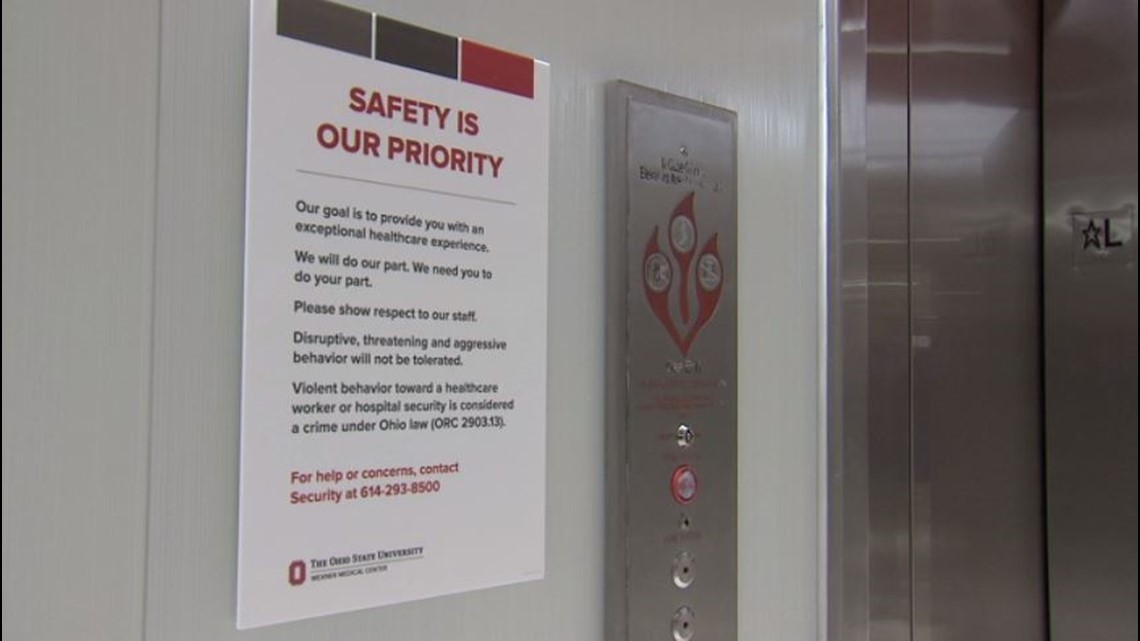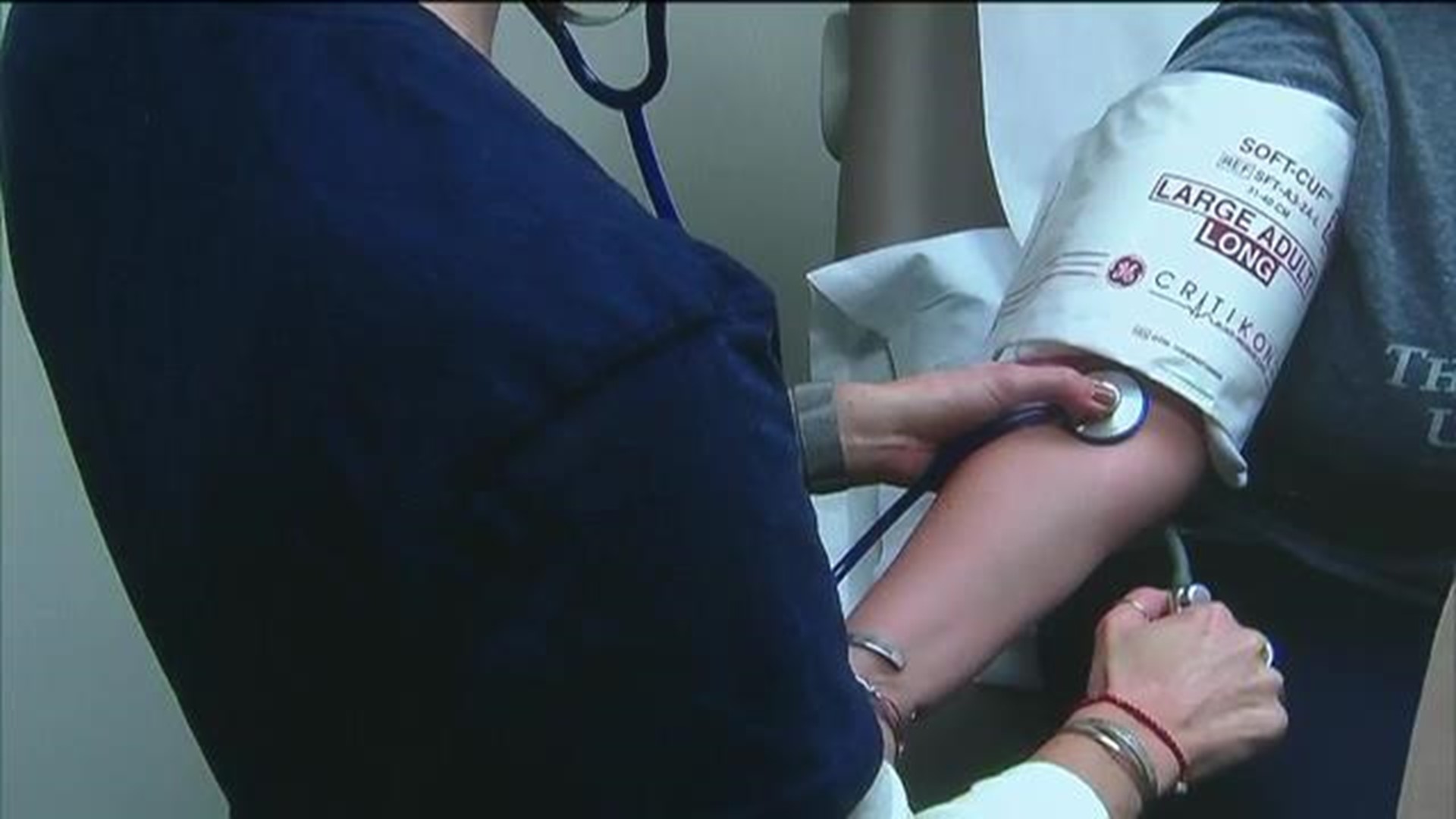COLUMBUS, Ohio — Nurses across the country and in Ohio are sounding the alarm about workplace violence, according a recent study by the National Association of Emergency Medical Technicians.
Studies show that healthcare workers are four times more likely to be physically assaulted in the workplace than any other American worker.
A recent study of the problem was written by two Ohio State University Wexner Medical Center Doctors.
An investigation by 10TV found the number of missed days for workplace violence at Ohio State Wexner Medical Center has fallen from 169 days in 2017 to 66 days last year. However, the number of reported assaults against nurses jumped from 9 cases the past two years to 20 cases in 2019.
"We would expect those numbers to go up because we actively encouraging reporting we want our staff to know that violence against a health care worker is a crime and we will support them in reporting to police and filing charges," said Elizabeth O'Connor Seely, Chief Administrative Officer Ohio State University Wexner Medical Center.
In response to the violence at the work place, Ohio State Wexner Medical Center created what’s called BERT or Behavioral Emergency Response Team made up of a team of nurses. The hospital says it’s responded 1,500 times in the past year.
Ohio Health declined to provide specific numbers of assaults against staff, but the hospital tells 10TV since 2014 the number of reported incidents of workplace violence has steadily and significantly increased.
"It's a disturbing trend and it's getting worse year after year," said Bradley Raetzke, MD, president of the Ohio Chapter of the American College of Emergency Physicians.
Ohio Health created a simulation room where actors play the role of a violent patients to help staff better train for unexpected. After the demonstration, the team conducts a debriefing session to learn what they did right and wrong.
Mt. Carmel also declined to provide specific workplace violence statistics. Instead, it sent us a statement saying, in part, "We understand that workplace violence is a growing concern in healthcare and one that we take seriously. We proactively alert staff when potentially violent situations are identified, and we've implemented de-escalation and assault-prevention training for our employees.”
Why is workplace violence among health care workers happening? Hospitals say it's a combination of factors.
"We're seeing a lot of drug and alcohol abuse I think psychiatric conditions and I think just general frustrations over medical care can lead to the boiling point," says Dr. Raetzke.
An emergency room can be a chaotic and violent place to work in.
Despite the fact that the largest hospitals in central Ohio have trained staff to handle violent patients, installed metal detectors at emergency room entrances and panic buttons, the violence continues.
The number of patient attacks is growing across Ohio and across the country.
According to the latest numbers from the Ohio Bureau of Labor statistics, patients who intentionally injure a staff member in the Hospital rose from 110 reported cases in 2012 to 340 by 2017.
Erika Anderson is a registered nurse from Cleveland.
She recalled the day she was attacked.
"I was scuffling with this man I fell, he fell. I hit my head. I hit my head hard,"she said.
She says the hospital where she worked didn't do a proper assessment.
"I found that I had a concussion," she said.
Chelsea Kesslman a registered nurse working in Columbus said she too was attacked by a patient.
She says it happened in a split second.
"Became aggressive at the drop of a hat. Three staff members were assaulted. We as nurses don't want to feel afraid to report situations that happened to us we don't want to go back to work when we might not be physically or mentally ready," she says.
At Ohio Health, a simulation room uses actors to play the role of a violent patients to teach staff how to recognize the signs and to deescalate the behavior.


" We're really developing a comprehensive way to train associates to detect even the earliest point of agitation," says Megan Schabbing, MD. Emergency Room Psychiatrist Ohio Health.
Ohio's Workplace Violence law took effect in 2012. Its aim is to protect health care workers by increasing the fines and penalties against those who commit violence acts health care professionals. The fine increased from $1,000 to $5,000 for an assault against a health care worker. The penalty increased from a misdemeanor fo a 5th degree felony when the offender has previously been convicted of an assault against a health care worker.


OSU and Ohio Health are raising awareness about violence in the workplace. Both have posted signs warning the public that violence against healthcare workers is a crime and punishable as a felony.
I'm not sure there's a lot of solid public awareness about that law that's why we're putting up the signage and referencing that law," says O'Connor Seely.
According to the Occupational Health and Safety Administration (OSHA), about 75% of nearly 25,000 workplace assaults reported annually occurred in healthcare and social service settings. While violence against healthcare workers occurs in all settings, hospital emergency departments and inpatient psychiatric facilities are the most common sites.
Erika Anderson who once worked as a nurse in an Ohio prison says if hospitals are serious about protecting staff from violent patients, they need to train everyone — not just nurses and doctors — to be ready for the unpredictable risk of patient violence.
"The training is inadequate for the situations we are placed in. I honestly feel safer on a prison compound with 3,000 inmates than I do in a hospital facility because everyone I worked with there is properly trained," she said.
According to surveys by the American College of Emergency Physicians and the Emergency Nurses Association, almost half of emergency physicians report being physically assaulted at work, while about 70 percent of emergency nurses report being hit and kicked while on the job. Furthermore, the vast majority — 80 percent — of emergency physicians say violence in the emergency department harms patient care. Similarly, emergency nurses report that the harmful consequences of experiencing a violent event at work interfere with the delivery of high-quality patient care.
The frequency of violent attacks on nurses, physicians and patients in our nation’s emergency departments is unconscionable and unacceptable. For medical professionals, being assaulted in the emergency department must no longer be tolerated as “part of the job.”
In an effort to meaningfully minimize these attacks and protect emergency department professionals, ENA and ACEP launched a new campaign called “No Silence on ED Violence.” This joint effort aims to support, empower and provide the resources our respective members need to effect safety improvements at their workplace, while engaging state and federal policymakers, stakeholder organizations and the public at large to generate action to address this crisis.
There is no Federal law against workplace violence among health care workers. However, The Workplace Violence Prevention for Health Care and Social Service Workers Act which the U.S. House of Representatives passed last year, but has not been voted on in the U.S. Senate, would direct OSHA to issue a standard requiring health care and social service employers to write and implement a workplace violence prevention plan to prevent and protect their employees from violent incidents.

